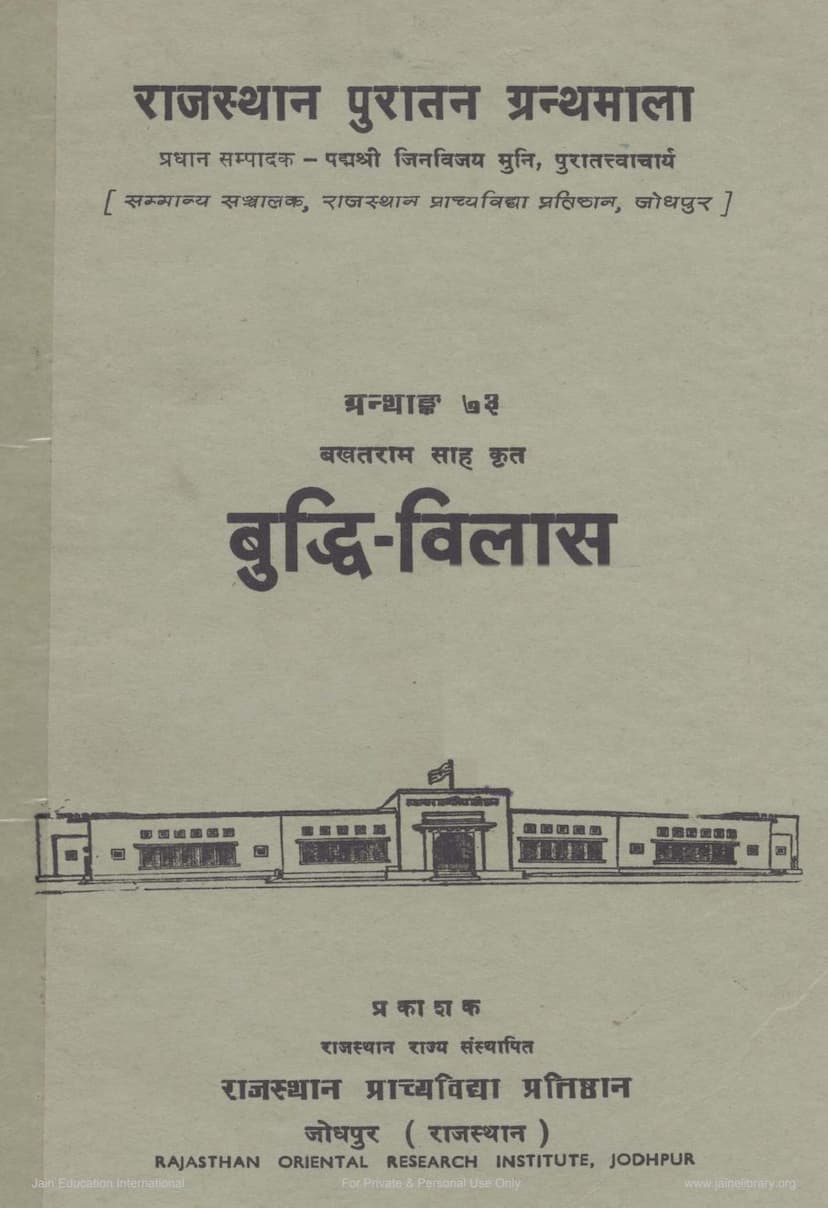Buddhivilas
Added to library: September 1, 2025

Summary
Here's a comprehensive summary of the Jain text "Buddhi Vilasa" by Bakhat Ram Saha, based on the provided information:
Title: Buddhi-Vilasa (बुद्धि-विलास) Author: Bakhat Ram Saha (बखतराम साह) Publisher: Rajasthan Oriental Research Institute, Jodhpur Series: Rajasthan Puratan Granthamala (राजस्थान पुरातन ग्रन्थमाला), No. 73 Publication Year: V.S. 2020 / 1964 A.D. Editor: Padma Dhar Pathak, M.A.
Overview:
"Buddhi-Vilasa" by Bakhat Ram Saha is a significant work published by the Rajasthan Oriental Research Institute. It is primarily a religious text, aiming to present the precepts of the Digambara Jain sect in a simple language accessible to common people. While its core purpose is religious instruction, it also incorporates historical and local elements, particularly concerning the history of the Kachwaha rulers of Amber and the foundation of Jaipur. The text is a compilation and simplification of various well-known Jain scriptures like the "Nitisara" of Indragani.
Key Content and Themes:
-
Religious Teachings: The book extensively covers the tenets of Jainism, including:
- Mangalacharan (invocation) and veneration of Tirthankaras and spiritual leaders (Acharyas, Upadhyayas, Sadhus).
- Descriptions of Jain cosmology, including heavens (swarga) and hells (naraka).
- The origin and propagation of the Digambara Jain sect, including the establishment of various seats (gacchas) in Rajasthan.
- Advice and teachings for monks (muni) and householders (shravak), emphasizing virtues like non-violence, truthfulness, non-stealing, celibacy, and non-possession.
- Detailed explanation of religious practices, vows, and rituals for both monks and lay followers.
- Discussions on scriptural knowledge, the twelve Angas, and the importance of adhering to the teachings of the Tirthankaras and learned scholars.
- The author also addresses the divergence of views within the Jain community, particularly mentioning the "Thirteen-Panthis" and the need to uphold the true Jain dharma.
-
Historical and Local Context:
- History of Jaipur and Kachwaha Rulers: A substantial portion of the work (around twenty-three pages) details the history of the Kachwaha rulers of Amber and Jaipur, bringing the narrative up to the author's own time. It describes the foundation of Jaipur by Sawai Jai Singh, observing the religious ceremonies involved. The author provides contemporary details, suggesting he may have been an eyewitness to some events.
- Local Influence: The author's association with Jaipur is evident throughout the text, with frequent mentions of Jaipur and its rulers.
- Social and Political Events: The text refers to significant events like the practice of "langoti" and palanquin riding by Bhattarak Prabha Chandra, the origin of the Khandelwal caste, and the ill-treatment of Jains by Shyam Tewadi, which was witnessed by the author.
-
Linguistic Features: The language is a blend of Braj and the Dhoondari dialect spoken in Jaipur, showcasing the influence of both languages on each other.
-
Author's Background: Bakhat Ram Saha, son of Pema Raja Saha, was a native of Chatsu, near Jaipur. He was a follower of the Digambara Jain tradition and wrote the "Buddhi-Vilasa" at the request of Pandit Kalyana and Muni Gunakirti of the Laskari temple. He also authored "Mithyātva Khandana Nāțaka."
Editorial Contributions:
The editor, Padma Dhar Pathak, has provided a thorough edition of the text, including an introduction, appendices, and variant readings. He based his work on two manuscripts from the Amber Shastra Bhandar. The foreword by Muni Jinavijaya highlights the book's significance in making Jain philosophy accessible and its value as a historical source.
Significance of the Text:
- Religious Value: It serves as a guide for spiritual practice and understanding Jain principles for the common follower.
- Historical Value: It offers valuable insights into the religious and social history of Jainism in Rajasthan, particularly in Jaipur, and provides contemporary accounts of local events and rulers.
- Linguistic Value: The unique blend of dialects makes it a useful resource for linguists studying the evolution of Rajasthani and Braj languages.
In essence, "Buddhi-Vilasa" is a multifaceted work that bridges religious instruction with historical narrative, offering a glimpse into the life and beliefs of the Jain community in medieval Rajasthan, presented through the accessible literary style of Bakhat Ram Saha.